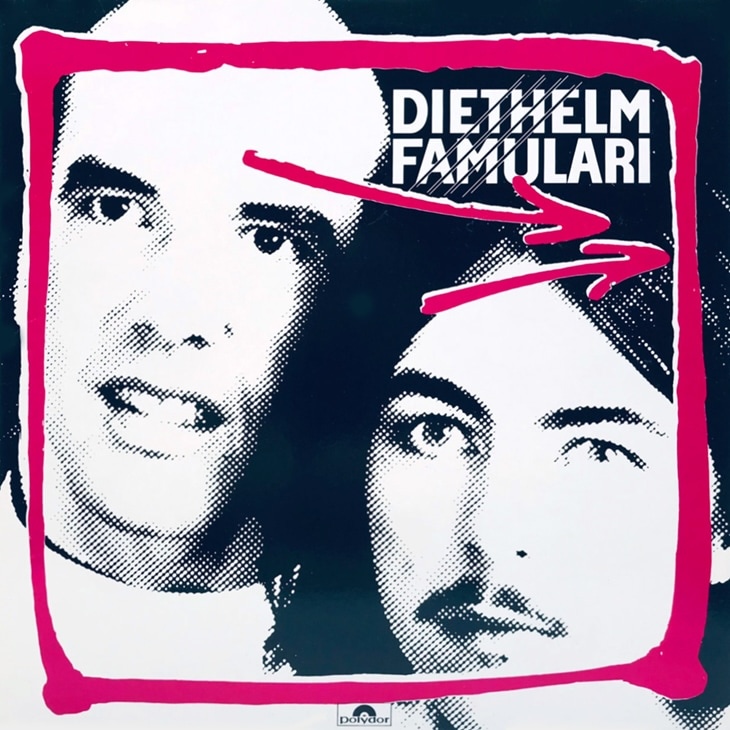No joke, I too sometimes feel puzzled as you might be with what gets shared on this blog. On a regular day, I’d skirt around sharing something like Thomas Diethelm and Santino Famulari’s Diethelm/Famulari. It could be because there’s little to no information about the musicians…a major reason I hold back, often. It could also be because the information out there appears incomplete (or worse), compromised or falsified. And, finally, it could be because even I think the album might be too leftfield for most to find worthwhile. Yet, today, here I am, sharing an album that breaks a lot of my unwritten rules.
One thing you can’t escape from the first note of Diethelm/Famulari is just how unflinchingly out of step it sounds. You hit play on “The Flyer” and you’re confronted with a maelstrom of acoustic guitar and synth lines. I struggle to find anything in my collection that sounds like it. On such music, I hear quirky strains of Canterbury prog (think Caravan or Camel) but as soon as I have the song pegged, the duo squirrel away their melodies elsewhere, hinting at the ethereal New Age of someone like Iasos (R.I.P.) or Harmonia or zag somewhere else, into the realm of Zappa-esque mutant fusion.

It’s that offbeat fusion of heady styles into something weirdly accessible that makes Diethelm/Famulari such a unique listen. Walking on that tightrope of excess and earnestness, a lot of the music you hear here on Diethelm’s and Famulari’s work sounds both positively contemporary, yet also completely alien.
You sort of understand why that’s so, if you dig a little deeper into the duo’s history. Much like Andreas Vollenweider, Büdi Siebert, and Friedemann, Thomas Diethelm and Santino Famulari were part of that late ‘70s scene centered around the German border of Switzerland and Austria, a scene that yielded such musicians trying to formulate a different kind of jazz music inspired more intimately by world music and “third stream” thinking. Overground, it’s a kind of music best exemplified by artists who performed at the influential Montreux Jazz Festival.
Thomas’s instrument of choice, the acoustic guitar, would lead him to experiment with early digital harmonizer and delay effects. On early recordings he could be heard playing acoustic and electric counterpoint to dialed-in melodies, affecting a kind of unplaceable jazz. On his solo debut, 1981’s Shaved, released on CAN’s Spoon Records, you get to hear his decidedly askew mastery of his instrument, stretching it’s technique into the realm of surprisingly accessible singer-songwriter music (albeit sung through a falsetto that belongs on a Yes record). As one can imagine, such oddball ideas only hinted at where he could go next.

Trying to tap into the burgeoning New Wave movement, Thomas went looking in that Swiss-based scene and found a simpatico partner to work with. Thankfully, he found one Santino Famulari, a pianist and composer who dabbled in sound design and was already used to performing live with the wildly successful Andreas Vollenweider. Together, they signed a deal with UMG (Universal Music Group) and crafted a record which played to their strengths as a unit.
Creating something more approximating an evolution of Teutonic-inspired kosmische musik, 1983’s Diethelm/Famulari (featuring the great Trilok Gurtu on percussion) struck a perfect balance of truly out-there acoustic riffing and surprisingly organic electronic atmosphere and melodies. Songs like “Full Moon” bely a gentle zig-zag of influences. Largely instrumental, it seemed like an album that could appeal to chin-stroking jazz heads and those rearing themselves on new school “new music”, that of the minimalist type rearing its head in America and bubbling up in Europe and Japan.
I can sort of imagine why a track like theirs, “The Flyer”, became a hit in the Netherlands, in 1983. In that very brief zeitgeist when Yes released “Owner Of A Lonely Heart” and audiences were primed for Godley & Creme’s “Cry”, more “adult” listeners were hungry for music that had that certain kind of sophistication (best heard in acts like The Alan Parsons Project) tied to a certain kind of accessibility. Songs like “Basta!”, delightful electro-tropical fusion, from Diethelm/Famulari sounded like a breath of fresh air in the increasingly style-conscious music scene. Stuff this earnestly wiggy had a certain unpretentiousness that does more than just wink at its audience.
So for lack of more to add, I’m jazzed for those who haven’t heard tracks like “Old Torero”, try to hear the little delightful contours to flamenco Santori adds with his synth contributions – or the wonderfully, swirly ultra-clean guitar playing that Thomas makes sound so effortless (when musicians know how hard it is to pull this melodicism out). Even Thomas’s funky singing comes back on their epic multi-part “Masquerade”, a meeting point between early, heavenly prog rock and the futuristic electro-fusion the duo is peddling. Ditto for the Santino led “Deep Green” – a great contender for early chill-out room playlists.
The album ends on “Too Late”, a sort of meta take on whatever the heck they were creating here. What begins as a funky slowly-filtering bit of post-disco builds to a far-out Zappa-esque synth freak out, making you think: What the hell did I just listen to hear? Something, on second thought, now I hear in Pyrolator’s Pyrolator’s Wunderland, another album sharing this album’s joyful experimentation. It’s those unplaceable feelings this album evokes that you feel compelled to go back to put it on again. Your guess here, once again, is as good as mine (as why such an album keeps calling us back to break some rules).

Reply